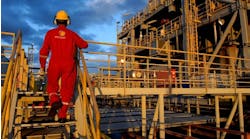Extreme deepwater conditions
While suppliers are increasing their attention to developing equipment for extreme high pressure/high temperature conditions, operators are characteristically cautious about adopting new technology, according to Roy Schilling of BP.
Schilling spoke recently at a conference on risk management sponsored by Det NorskeVeritas. Schilling discussed extreme high pressure/high temperature in conjunction with deepwater production. He defined XHPHT as any pressure over 15,000 psi and temperature above 350° F.
XHPHT conditions are often found in the Gulf of Mexico ultra-deepwater up to 10,000 ft. In the GoM, there are a number of layers of production zones, Christian Markussen, DNV group leader, technology qualification, explained. As operators drill deeper, there’s more mass on top of these wells, which increases pressure. And the deeper they drill, the higher the temperature, he said.
“The wellhead gets the brunt of the conditions. It sees the high pressures and temperatures,” Markussen said. In addition to the wellhead, all the associated equipment that you need to drill, work-over, and complete the wells is affected.
Markussen said some of DNV’s clients are talking to suppliers about developing new technology needed to withstand these conditions. But it is new technology that operators fear. “It is all about managing the risk of new technology,” he explains. “A lot of companies have been burned using new technology. We define new technology as a brand new technology that has never been used anywhere in this industry before or existing equipment that is brought into new operating conditions.”
Equipment rated to 15,000 psi and 300° F is available, but when dealing with XHPHT, there is no technology proven to handle those conditions. “It is not only a question of adding more steel,” Markussen said. “Being able to manufacture it to the right quality and reliability is going to be a challenge.”
Development of new technology is in the works. There are a lot of flow assurance issues associated with XHPHT. The industry is looking at HIPPS, subsea separation, and multiphase and downhole boosting. There’s also a lot of work being done on sensor technology such as monitoring load conditions for risers. Add to that the issue of weight. For a HP well, a heavy wall thickness is needed, which requires the vessel to have more buoyancy and stronger mooring. DNV is developing better analytical techniques to deal with these issues. The company is doing analysis to get a better handle on the motion of the vessel, risers, and how much heave loading affects the vessels.
“To compound the problem is reliability,” Markussen explained. “The demand for reliability is much more important when working over a deepwater well. It takes months,” he said, “and the cost of one extra work-over could potentially kill a project economically.”
DNV is working with DeepStar to manage this risk. The objective of the DeepStar study is to examine the potential subsea system design configurations and alternatives, identifying technology gaps, and develop timelines for equipment/technology readiness.
Lease sales
Near-record oil and gas prices led to robust bidding in two offshore federal lease sales, the MMS reports. The Central Gulf of Mexico Lease Sale 194 garnered $353,961,798 in high bids from 80 companies for oil and natural gas leases in the Gulf of Mexico. The total of all bids was $540,254,193. Eastern Gulf of Mexico Lease Sale 197 exceeded expectations resulting in $ 6,974,531 in total bids.
In sale 194 the agency received 651 bids on 428 tracts. In this sale, the MMS offered 4,063 tracts comprising approximately 21.4 million acres offshore Alabama, Louisiana, and Mississippi.
In sale 197, the agency received 12 bids on 12 tracts. The lease sale area encompasses the unleased blocks in a section of the Eastern Gulf of Mexico outer continental shelf planning area directly south of Alabama. These 124 unleased blocks cover more than 714,240 acres and are from 100-196 mi offshore in water depths of 1,600 to more than 3,425 m. Estimates of undiscovered economically recoverable hydrocarbons in this lease range from 65-85 MMbbl of oil and 0.265-0.34 tcf of natural gas.
While interest in the deepwater continues, the large number of tracts receiving bids in shallow water is of particular note.
“We believe this reflects definite industry interest in deep gas in shallow waters, as well as deepwater oil and gas production in response to royalty relief offered by MMS,” MMS Director Johnnie Burton says.
Stone Energy Corp. and Dominion Exploration & Production Inc. submitted the highest bid in Lease Sale 194 of $21,157,755 for West Cameron block 132. The second highest bid received was $20,153,300 submitted by Murphy Exploration & Production Co., Dominion Exploration & Production Inc, Pioneer Natural Resources USA Inc., and Spinnaker Exploration Co. LLC for Mississippi Canyon block 819.
Helis Oil & Gas Co. LLC, Houston Energy LP, and Red Willow Offshore LLC submitted the highest bid in Lease Sale 197 of $ 2,037,379 for Lloyd Ridge block 272. The second highest bid received was $1,566,000 submitted by Spinnaker Exploration Co. LLC and Dominion Exploration & Production Inc. for De Soto Canyon block 797.
Petronius returns to production
ChevronTexaco says its Hurricane Ivan-damaged Petronius platform initiated production in early March. Hurricane Ivan¿s eye passed almost directly over Petronius last September. Significant damage occurred to the rig crew quarters, production equipment, and deck structures. Petronius is 130 mi southeast of New Orleans. Prior to Hurricane Ivan, Petronius averaged 42,000 b/d and 65 MMcf/d. ChevronTexaco is the operator of Petronius with 50%. Marathon Oil Corp. holds the remaining 50% interest.




